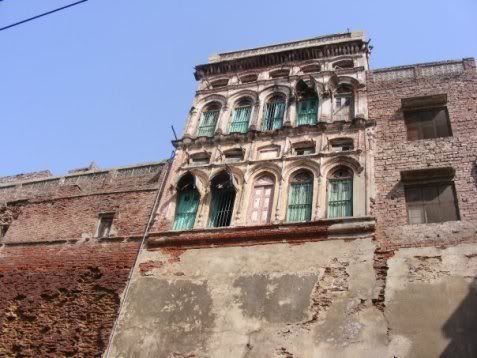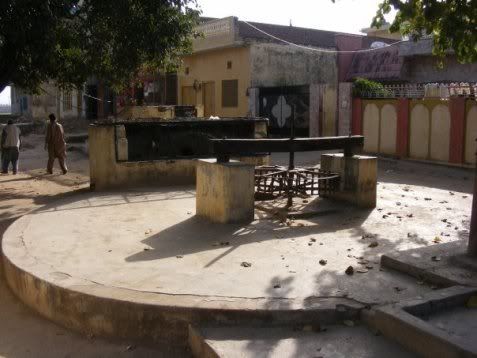While cities are dynamic centres of creativity, commerce and culture, these benefits are often undercut by environmental problems, lack of civic amenities, inefficient governance, and administration. Centuries old historic city Gujrat is a classic example where one can see all the hazards of urbanization.

There are many tales about the remote origin of the place. As per one legend Gujrat was founded by daughter in law of famous Raja Rissalu. Like most historic cities it has been ruined and reconstructed many times in the era gone by. During the rule of Mughal King Akbar, it was called Akbarabad. The final battle between Sikhs and the British (under the command of Lord Gough) was fought here. In the centre of the town there are relics of Akbar’s Fort and a Bawli (bath house locally called Akbari Hamam) of the same period.
Commuter who prefer to drive on familiar and congested Grand Trunk Road (N5) rather than going on isolated Islamabad-Lahore Motorway pass through Gujrat city that has stretched from bridge on the River Chenab to the bridge on Bhimbar Flood Stream.
There is an airstrip in the suburbs of Gujrat from where fighter airplanes used to fly during World War II. Citizens learn driving on that disused strip these days. The people of Gujrat are motivated, ingenious, and industrious. These are outstanding characteristics of the people of Gujrat, which enable them not to be bogged down by status quo. During all Indo Pak wars, the people exhibited an exemplary courage and resilience. Nishan-e-Haider – highest gallantry military award – has been conferred upon many sons of the soils that are the testimony to the fact.
Gujrat is notable for ceramics, which brings to mind the fact that the town is the setting of the famous Panjabi romance about Sohni and Mahinwal. Folk lore has it that Sohni was a potter’s daughter who used to swim across the River to meet Mahinwal using a pot as a buoyancy aid. One night her jealous sister in law exchanged the pot for an unbaked one which dissolved in water.
On the other bank, Mahinwal, hearing Sohni’s wails jupmed into the water but was unable to save her. Unable to face the prospect of life without her, he also let himself go and joined her in death. The folk lore has been composed in Punjabi poetry and is sung where ever Punjabi language is spoken.
Besides ceramics, Gujrat is also famous for furniture items. Special furniture of international quality is made here and sold all over the country. This internationally acclaimed craft of the town needs an institutional patronization and an extensive efforts for international marketing. It can be a potent source of earning foreign exchange if attention is paid to and earnest efforts are made in this regards. Sadly, the ineptitude of those responsible for export promotion do not see this and the unique potentials are not being taped yet. Similarly the fan and shoes industries are also the town’s claim to fame.
As Gujrat began to evolve into a more industrialized town, it started growing without any planning. The rapid rate of population growth and torrent of migration from countryside have strained the capacity of basic civic services. The population of Gujrat has mushroomed; unplanned abadis have sprung up around town, which has spread much beyond the defined municipal limits. Result: town is facing problems like none existing sanitation, contaminated water supplies, air and noise pollution, encroachments and congested streets. Even the new bypass around the town is packed with traffic and lined with shops and houses on both sides.
The buss terminal was shifted out of the town but the town has already grown past the terminal. The public property where in the past used to be Government Transport Service Terminal still stands deserted right on the Grand Trunk Road.
There is an acute shortage of houses and the real state prices are skyrocketing. Since land is essential for urban growth, devising equitable and efficient land development policies is one of the major challenges facing planners and policy makers in the town.
Without any proper arrangements, people deposit their waste in streets, where domestic animals are also live freely, or at any open space they find. The streets are completely littered with trash. The toxic smoke from the garbage put on fire and stinking smell coming out of waste in the streets are making the lives of people increasingly miserable.
Animal transport is probably the most pervasive and most correctable problem of Gujrat. The common means of transport in the town is sturdy and inexpensive tonga. It is Gujrat’s vehicle of convenience, which has come to symbolize the town. The tongas (and rehris) move very slow and can not keep pace with other traffic – hence cause traffic congestion on dilapidated roads where right of way has already been reduced due to excessive encroachments. The district headquarters is without any public transport system so tongas are doing good business.
Lots of young boys are also seen holding the reins of horses put before the tongas overloaded with passengers and goods. Accidents involving animals (untrained, wild, or afraid horses or unwilling donkeys) are the commonest scenes on roads of the town. Much more than tongas and rehris registered with Municipal Committee come from the suburbs to do the business in the town every day.

The units of fan industry are spread in the residential areas. The tar-coal drums, electric wires, and old tyres are burnt in order to separate the iron from them in furnaces inside the residential areas that emit poisonous gases. Town traffic and heavy traffic plying on Grand Trunk Road also add to the air (and noise) pollution in this soot-choked town. These gases are very harmful for human health.
A short walk in the town reveals the neglect of all concerned. The town of saints, powerful political families, actors, and spirited people may be managed efficiently with a little attention and futuristic planning.
A lot has changed in historic Gujrat city. Some for good and some for bad. The city however, still deserves a visit from a causal as well as a planned visitor. Do make a stop over here on your next visit. You will be in for a treat.



















































Dear Mister Shirazi and ATP Team,
I am very thankful to you for writing of such a quality article about Gujrat.
Gujrat is a rich of history city of Pakistan.